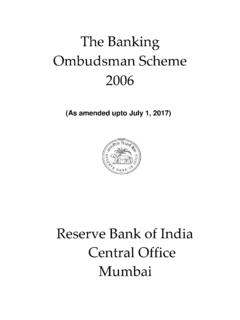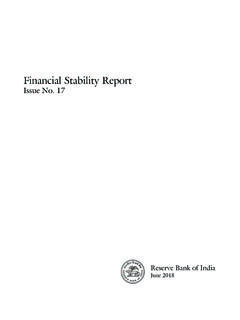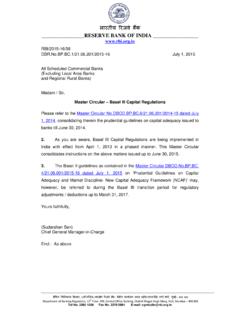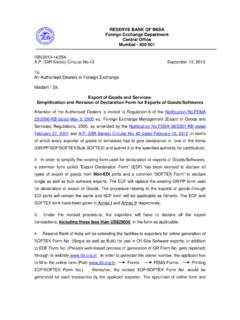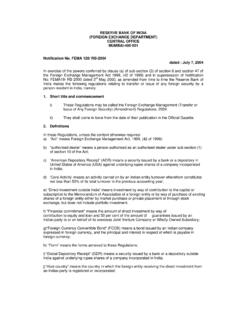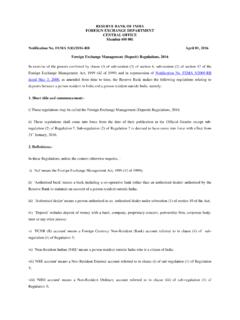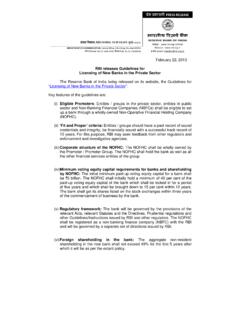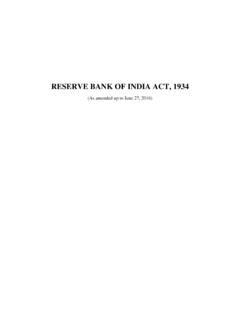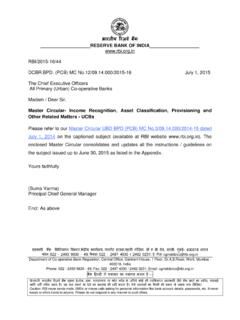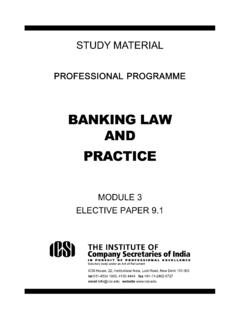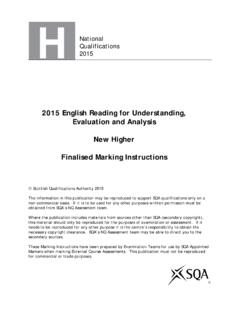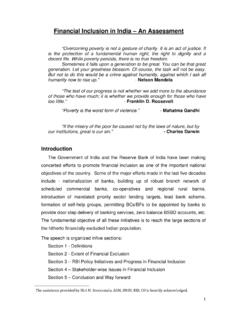Transcription of ANNEX REVISED SCHEME FOR ISSUE OF KISAN CREDIT …
1 ANNEX REVISED SCHEME FOR ISSUE OF KISAN CREDIT CARD (KCC) 1. Introduction The KISAN CREDIT Card has emerged as an innovative CREDIT delivery mechanism to meet the production CREDIT requirements of the farmers in a timely and hassle-free manner. The SCHEME is under implementation in the entire country by the vast institutional CREDIT framework involving Commercial Banks, RRBs and Cooperatives and has received wide acceptability amongst bankers and farmers. However, during the last 13 years of implementation, many impediments were encountered by policy makers, implementing banks and the farmers in the implementation of the SCHEME .
2 Recommendations of various Committees appointed by GOI and studies conducted by NABARD also corroborate this fact. It was, therefore, felt necessary to revisit the existing KCC SCHEME to make it truly simple and hassle free for both the farmers and bankers. Accordingly, the GOI, Ministry of Finance constituted a Working Group to review the KCC SCHEME . Based on the recommendations of the Working Group which were accepted by the GoI, the following guidelines are issued: 2. Applicability of the SCHEME The REVISED KCC SCHEME detailed in the ensuing paragraphs is to be implemented by Commercial Banks, RRBs, and Cooperatives.
3 The SCHEME provides broad guidelines to the banks for operationalising the KCC SCHEME . Implementing banks will have the discretion to adopt the same to suit institution/location specific requirements. 3. Objectives/Purpose KISAN CREDIT Card SCHEME aims at providing adequate and timely CREDIT support from the banking system under a single window to the farmers for their cultivation & other needs as indicated below: a. To meet the short term CREDIT requirements for cultivation of crops b. Post harvest expenses c. Produce Marketing loan d. Consumption requirements of farmer household e.
4 Working capital for maintenance of farm assets and activities allied to agriculture, like dairy animals, inland fishery etc. f. Investment CREDIT requirement for agriculture and allied activities like pump sets, sprayers, dairy animals etc. Note: The aggregate of components a. to e. above will form the short term CREDIT limit portion and the aggregate of components under f will form the long term CREDIT limit 4. Eligibility i. All Farmers Individuals / Joint borrowers who are owner cultivators ii. Tenant Farmers, Oral Lessees & Share Croppers iii. SHGs or Joint Liability Groups of Farmers including tenant farmers, share croppers etc.
5 Fixation of CREDIT limit/Loan amount The CREDIT limit under the KISAN CREDIT Card may be fixed as under: All farmers other than marginal farmers: The short term limit to be arrived for the first year: For farmers raising single crop in a year: Scale of finance for the crop (as decided by District Level Technical Committee) x Extent of area cultivated + 10% of limit towards post-harvest / household / consumption requirements + 20% of limit towards repairs and maintenance expenses of farm assets + crop insurance, PAIS & asset insurance. Limit for second & subsequent year :First year limit for crop cultivation purpose arrived at as above plus 10% of the limit towards cost escalation / increase in scale of finance for every successive year ( 2nd , 3rd, 4th and 5th year) and estimated Term loan component for the tenure of KISAN CREDIT Card, , five years.
6 (Illustration I) For farmers raising more than one crop in a year, the limit is to be fixed as above depending upon the crops cultivated as per proposed cropping pattern for the first year and an additional 10% of the limit towards cost escalation / increase in scale of finance for every successive year (2nd, 3rd, 4th and 5th year). It is assumed that the farmer adopts the same cropping pattern for the remaining four years also. In case the cropping pattern adopted by the farmer is changed in the subsequent year, the limit may be reworked. (Illustration I) Term loans for investments towards land development, minor irrigation, purchase of farm equipments and allied agricultural activities.
7 The banks may fix the quantum of CREDIT for term and working capital limit for agricultural and allied activities, etc., based on the unit cost of the asset/s proposed to be acquired by the farmer, the allied activities already being undertaken on the farm, the bank s judgment on repayment capacity vis-a-vis total loan burden devolving on the farmer, including existing loan obligations. The long term loan limit is based on the proposed investments during the five year period and the bank s perception on the repaying capacity of the farmer Maximum Permissible Limit: The short term loan limit arrived for the 5th year plus the estimated long term loan requirement will be the Maximum Permissible Limit (MPL) and treated as the KISAN CREDIT Card Limit.
8 Fixation of Sub-limits for other than Marginal Farmers: i. Short term loans and term loans are governed by different interest rates. Besides, at present, short term crop loans are covered under Interest Subvention SCHEME / Prompt Repayment Incentive SCHEME . Further, repayment schedule and norms are different for short term and term loans. Hence, in order to have operational and accounting convenience, the card limit is to be bifurcated into separate sub limits for short term cash CREDIT limit cum savings account and term loans. ii. Drawing limit for short term cash CREDIT should be fixed based on the cropping pattern and the amounts for crop production, repairs and maintenance of farm assets and consumption may be allowed to be drawn as per the convenience of the farmer.
9 In case the revision of scale of finance for any year by the district level committee exceeds the notional hike of 10% contemplated while fixing the five year limit, a REVISED drawable limit may be fixed and the farmer be advised about the same. In case such revisions require the card limit itself to be enhanced (4th or 5th year), the same may be done and the farmer be so advised. For term loans, installments may be allowed to be withdrawn based on the nature of investment and repayment schedule drawn as per the economic life of the proposed investments.
10 It is to be ensured that at any point of time the total liability should be within the drawing limit of the concerned year. iii. Wherever the card limit/liability so arrived warrants additional security, the banks may take suitable collateral as per their policy. For Marginal Farmers: A flexible limit of ,000 to ,000 be provided (as Flexi KCC) based on the land holding and crops grown including post harvest warehouse storage related CREDIT needs and other farm expenses, consumption needs, etc., plus small term loan investments like purchase of farm equipments, establishing mini dairy/backyard poultry as per assessment of Branch Manager without relating it to the value of land.
